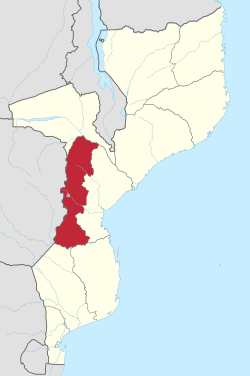Manica Province
Manica is a province of Mozambique. It has an area of 62,272 km² and a population of 1,945,994 (2017 census).[1] The province is surrounded by Zimbabwe in the west, Tete Province in the northwest, Sofala Province in the east, Save River in the south, and Zambezi river in the northeast.[3] Chimoio is the capital of the province.[4] The highest mountain in Mozambique, Mount Binga (2436 m), lies in this province[5] near the border with Zimbabwe. The Manica province is divided into nine districts and 34 administrative regions.
Manica | |
|---|---|
 Looking down from Mount Zembe | |
 Manica, Province of Mozambique | |
| Country | Mozambique |
| Capital | Chimoio |
| Government | |
| • Governor | Alberto Mondlane |
| Area | |
| • Total | 62,272 km2 (24,043 sq mi) |
| Highest elevation | 2,436 m (7,992 ft) |
| Population (2017 census) | |
| • Total | 1,945,994 |
| • Density | 31/km2 (81/sq mi) |
| [1] | |
| Postal code | 22xx |
| Area code(s) | (+258) 251 |
| HDI (2017) | 0.472[2] low · 3rd of 11 |
| Website | www |
| [1] | |
History
The province was the part of ancient Manica kingdom.[3] In 8th century the province came under the control of Munhumutapa Empire and had commercial relations with Arab-Swahili traders in the coastal regions. Later it came under the Portuguese influence. The territory of the current province was part of the grant of the Mozambique Company, established in 1891. With the reversal of the territory for direct Portuguese colonial administration in 1942, the "District of Beira" was established, which came to be known as the "District of Manica and Sofala" in 1947. On 5 August 1970 this district was divided into "District Vila Pery" (the old name of Chimoio) and "District of Sofala". During the period of the transitional government (7 September 1974 to 25 June 1975) the District of Vila Pery was renamed "Province of Vila Pery" and later to its present name.[6] In 2008, when the incumbent president of Zimbabwe, Robert Mugabe lost the first round of the presidential elections, violence broke out in the country. This forced large number of people to flee to Manica.[7]
The province is headed by a provincial governor who is appointed by the President. Raimundo Diomba was the governor from 2005–07, Maurício Vieira from 2007 to 2010.[8] Ana Comoana is the current provincial governor.[9] Landmines are present in the province and deaths caused by them have been reported.[10]
Demographics
| Year | Pop. | ±% p.a. |
|---|---|---|
| 1980 | 641,200 | — |
| 1997 | 1,039,463 | +2.88% |
| 2007 | 1,438,386 | +3.30% |
| 2017 | 1,945,994 | +3.07% |
| source:[11] | ||
Economy
The inhabitants practice subsistence farming. Main products are maize, cassava and goat meat. Agriculture is favored by the high rainfall and mild climate. Cashews were once an important export product. Manica Province is rich in terms of gold,[12] copper and base metal.[13] Many farm workers from Zimbabwe have migrated to the province because of the conflicts in their country.[14] The total number of such migrants is disputed and may range from 4,000 to 40,000.
Districts
Manica Province is divided into 12 districts:
- Báruè District
- Chimoio District
- Gondola District
- Guro District
- Macate District
- Machaze District
- Macossa District
- Manica District
- Mossurize District
- Sussundenga District
- Tambara District
- Vanduzi District
In 2013, the Mozambican government created Chimoio and Macate districts from portions of Gondola District, and Vanduzi District from portions of Manica and Gondola districts.[15][16]
References
- "Estatísticas do Distrito de Bárue. Instituto Nacional de Estatística. Ano 2008" [Statistics District Bárue. National Institute of Statistics. year 2008] (PDF) (in Portuguese). Government of Mozambique. Retrieved 23 September 2014.
- "Sub-national HDI - Area Database - Global Data Lab". hdi.globaldatalab.org. Retrieved 2018-09-13.
- Briggs 2014, p. 209.
- Briggs 2014, p. 211.
- Briggs 2014, p. 221.
- Derman & Kaarhus 2013, p. 71.
- Derman & Kaarhus 2013, p. 78.
- "PR quer governação aberta e inclusiva" [PR wants open and inclusive governance]. Imensis citando Noticias (in Portuguese). 26 October 2007. Archived from the original on 16 March 2014. Retrieved 23 September 2014.
- "Eis a composição ministerial do novo governo" [The ministerial composition of the new government]. O País online (in Portuguese). 18 January 2010. Retrieved 23 September 2014.
- Vines, Alex (1997). Still Killing: Landmines in Southern Africa. Human Rights Watch. p. 72. ISBN 978-1-56432-206-7.
- Cameroon: Administrative Division population statistics
- Hilson 2006, p. 220.
- Review of the Economic and Social Plan, p. 75.
- Derman & Kaarhus 2013, p. 18.
- "Parlamento aprova criação de 13 novos distritos no país". Notícias. 22 March 2013. Retrieved 16 April 2020.
- "DPIC Manica". Ministério da Indústria e Comércio. Retrieved 16 April 2020.
Bibliography
- Briggs, Philip (2014). Mozambique. Bradt Travel Guides. ISBN 978-1-84162-496-9.CS1 maint: ref=harv (link)
- Derman, Bill; Kaarhus, Randi (2013). In the Shadow of a Conflict. Crisis in Zimbabwe and Its Effects in Mozambique, South Africa and Zambia. African Books Collective. ISBN 978-1-77922-217-6.CS1 maint: ref=harv (link)
- Hilson, G.M. (2006). The Socio-Economic Impacts of Artisanal and Small-Scale Mining in Developing Countries. CRC Press. ISBN 978-0-203-97128-4.CS1 maint: ref=harv (link)
- Republic of Mozambique: Review of the Economic and Social Plan for 2007. International Monetary Fund. p. 75. GGKEY:5XJ8WCSL5BH.